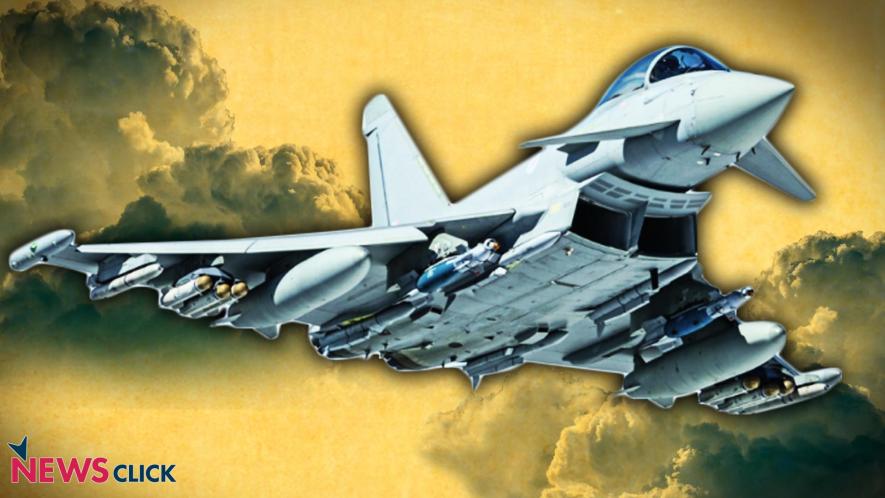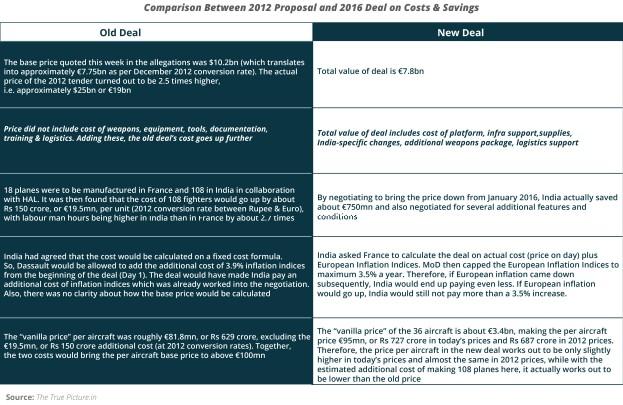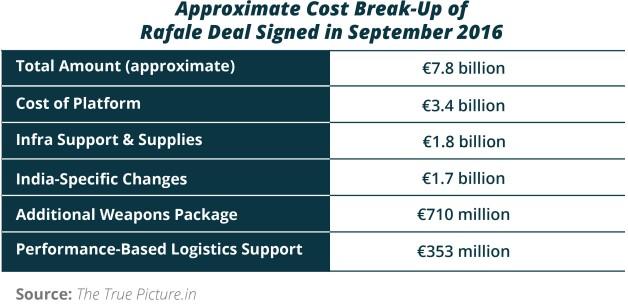Rafale Jets: Stink Grows From a Dubious Deal

There is a consensus that the Medium Multi-Role Combat Aircraft (MMRCA) deal of 2012 cannot be compared with the Inter-Governmental Agreement (IGA) of 2016 because of the different mix in each agreement. One involved ToT [transfer of technology] and manufacturing & maintenance by HAL. The other, in order to compensate for doing away with maintenance and manufacturing by HAL, hinged on a different mix of serviceability and weapons. Yet, the unnamed officials who brief the journalists and ministers never fail to boast, taking que from Prime Minister Narendra Modi who with President Hollande by his side announced the deal on April 10, 2015, saying that his deal is “on better terms and conditions than were offered to India in a spate procurement process”.

But even those who pretend to be non-partisan suddenly fall quiet when the offset deal is brought into the picture. They become evasive by hiding behind the stock argument that if two private companies come together, it is their prerogative to do so.
But this is not a civil marriage between two companies. It is a military deal and it matters who gets the offset deal. It matters if it is a public sector unit or a private sector company. It matters if the private sector company meets the criterion the government itself announced with much fanfare when announcing the policy on Strategic Partners for buy-and-make-in India. But ‘bhakts’ do not care so much for the security of the country, despite their jingoism, as they do for defending the ruling party, whatever it takes.
Consider this explanation which appeared in “The True Picture”
Charge: The interests of “one industrial group” or Reliance Defence Limited was promoted, since Reliance tied up with Dassault in October 2016 for a joint venture.
Fact: Private players have come into India’s defence production and how two firms choose to work with each other, or not, whether they engage in a tie-up, is entirely a matter between the two parties involved. The Indian government was not involved in this process. More importantly, the acquisition of the 36 Rafale aircraft did not involve any private player. It is completely an agreement between two governments.
So for most neo-liberal reporters, it really does not matter which Indian private sector company gets selected because they have made up their mind that public sector is in any case useless in comparison to even the most dubious corporate house. Such dogma when applied in the military sector, which forms the core of national security, can be disastrous. With private sector engaged in the practice of loot-PSU-banks-and-then-scoot with or without the connivance of the government/s, this faith in the virtues of the private sector would have been touching but for the fact that in the security field it can turn fatal.
In fact, for all the hue and cry over the working of the public sector, the corporate media is loath to look closely at the antecedents of the corporate house which landed a windfall deal of Rs 29,000 crore when it has absolutely no experience in the field.
Besides, there were enough leads to pursue because Dassault has gone on record, claiming that they were informed by the Government of India that HAL had its hands full and could not sign the offset deal. Did anyone bother to find out from HAL if this was true? We know for a fact that Dassault expressed concern over the highest echelons of the Indian government pushing them to strike the offset deal with a particular corporate house. Since the sole corporate house present in Paris in April 2015 along with PM Narendra Modi is well known, why did the media not pursue this issue and chose to remain happy with just passing whatever was dished out to them by officials as ‘god’s own truth’ requiring no scrutiny? We know that the one corporate house Dassault approached for the offset deal was ADAG and not some company with at least some track record in the military sector.
Dassault even expressed concerns over the “financial capabilities” of the corporate house “recommended” by the government. (“Rafale Deal faces hurdles”; Josy Joseph, The Hindu 30/09/2015).
It is this that gives the game away and reveals the desperate extent to which BJP government can stoop to cover-up the stench from the Rafale deal and have the corporate media fall in line. There is a concerted effort to sidetrack the issue of how the interest of a corporate house was promoted in a military deal, a public sector company with established track record sidelined and how this imperils country’s security.
Purchasing fighter jets from Dassault is not like any other business or trade deal. To swing, from being cavalier about which private company Dassault tied up with to getting shrill over the security dimension of the deal, so much so that the Union Government could not even share the information with Parliament, which its officials provide to select journalists, speaks volumes about the fact that the government has much to hide. By handing out the same facts, which compare selected bits of information to arrive at the price difference, again and again may satisfy the ‘bhakts’ of the BJP government but leave many more questions unanswered.

It is claimed that HAL’s manpower requirement was 2.7 times that of Dassault which would have pushed up the costs. An admirer of Narendra Modi, journalist Nikhil Gokhale claims that “when negotiations for the cost of 108 fighters began, it was discovered that the cost would go up substantially (in fact to the tune of Rs 150 crore per plane) since the cost the labour man hours in India were 2.7 times higher than in France! Moreover, then Defence Minister AK Antony had put down on file a remark that the negotiating team must come back to him before finalising the contract, creating more confusion for the negotiators”.
On both grounds he leaves many questions unanswered. The file noting he refers to, we now know since AK Anthony broke his silence, actually was to make sure that the lifecycle cost condition was sorted out with the Ministry of Finance ahead of the proposal being sent to the CCS and meant for the next government. As for the manpower requirement being 2.7 times that of Rafale, it is exceedingly doubtful that the manpower “cost” could be higher in India than for Dassault. Indeed no details are provided or vouched for such assertion. [“How Indian negotiators brought down the price of Rafale jets” by Nitin A Gokhale, Bharatshakti.in, September 23, 2016].
More to the point, no one bothered to find out from HAL if all this was true. No one bothered to ask how come HAL, which alone was capable of absorbing technology transferred to it for manufacturing, and enjoyed a relationship with Dassault spanning at least five decades, got sidelined and Dassault chose to go to ADAG, a novice, of their own volition?
The Indian government it is said had nothing to do with it because the private company was not involved in negotiating the purchase of the 36 Rafale jets and therefore there is no hanky panky in this deal. But the serious issue here is that the Indian PM cancelled a near done deal with a new one at an expensive price and then the offset deal was conveniently lapped up by a corporate ally of the Narendra Modi government by ensuring that HAL was kept out, which only the government could ensure.
Even on the price front , while the two deals cannot be compared, it is still possible to separate chaff from grain. For instance, the price for the MMRCA deal even at Rs 765.4 cr for each fighter jet at 2015 exchange rate included everything including ToT, spares, maintenance etc. Whereas the IGA per jet cost minus the weapons and new features, would be higher if spares and components are added. Thus the cost of 36 platforms of €3.4 billion plus spares €1.8 would take the cost to €5.2 billion. At the 2015 exchange rate, the price comes to Rs 3,95,200 cr, and the unit cost to a little less than Rs 1100 cr.
Indeed even if spare be removed and just bare frame price calculated, a pro-government cost analysis cannot deny that the per-unit price is higher for Rafale in the IGA 2016 deal than in the 2012 MMMRCA. The additional cost referred to below is for manufacturing it in India.

Besides, by handing out figures to select journalists, who toe the same old official line, and denying the same information to Parliament, the government has made sure they remain in plausible denial mode. Providing the same information in Parliament makes the facts authoritative and subject to a privilege motion if the government is found wanting on facts.
It is also interesting that the BJP hesitates to provide Parliament with any information about the Rafale deal, citing national security, but the pro-BJP experts have been writing about the missiles or the weapon mix and other features including the Meteor air-to-air missiles and the SCALP, air-to-ground missiles. If such information does not compromise national security why turn coy presenting the same to Parliament? And, in the same vein, encourage sycophants to rant against public sector HAL, abusing them on selectively provided information by the Ministry of Defence , making sure that HAL keep its mouth shut and does not refute the half-truths being spread.
Finally, whatever the comparison between the two deals, the fact is that the Rafale deal for 36 fighter jets iwith everything included at Rs 1600 cr per jet is much too costly, benefits the French company Dassault and undermines indigenous capability building by bringing in a private partner whose qualifications leave much to be desired, if not downright questionable. Worst of all, such a private partner would suit the French OEM perfectly to enable the best terms for themselves in offset servicing and, thus, make hollow the real purpose of the offset clause which was to ensure that benefits accrue and indigenous capabilities get created in India.
Get the latest reports & analysis with people's perspective on Protests, movements & deep analytical videos, discussions of the current affairs in your Telegram app. Subscribe to NewsClick's Telegram channel & get Real-Time updates on stories, as they get published on our website.






















